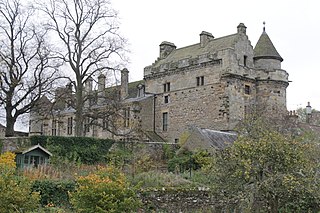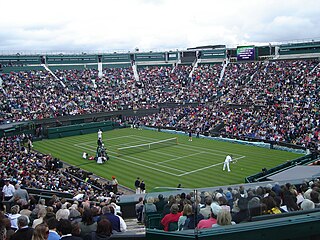
On 20 June 1789, the members of the French Third Estate took the Tennis Court Oath in the tennis court which had been built in 1686 for the use of the Versailles palace. Their vow "not to separate and to reassemble wherever necessary until the Constitution of the kingdom is established" became a pivotal event in the French Revolution.

Jeu de paume, nowadays known as real tennis, (US) court tennis or courte paume, is a ball-and-court game that originated in France. It was an indoor precursor of tennis played without racquets, and so "game of the hand", though these were eventually introduced. It is a former Olympic sport, and has the oldest ongoing annual world championship in sport, first established over 250 years ago. The term also refers to the court on which the game is played and its building, which in the 17th century was sometimes converted into a theatre.

Real tennis – one of several games sometimes called "the sport of kings" – is the original racquet sport from which the modern game of tennis is derived. It is also known as court tennis in the United States, formerly royal tennis in England and Australia, and courte-paume in France. Many French real tennis courts are at jeu de paume clubs.

Fives is an English handball sport derived from jeu de paume, similar to the games of handball, Basque pelota, and squash. The game is played in both singles and doubles teams, in an either three- or four-sided court.

Jeu de Paume is an arts centre for modern and postmodern photography and media. It is located in the north corner of the Tuileries Gardens next to the Place de la Concorde in Paris. In 2004, Galerie Nationale du Jeu de Paume, Centre national de la photographie, and Patrimoine Photographique merged to form the Association Jeu de Paume.

Dunfermline Palace is a ruined former Scottish royal palace and important tourist attraction in Dunfermline, Fife, Scotland. It is currently, along with other buildings of the adjacent Dunfermline Abbey, under the care of Historic Environment Scotland as a scheduled monument.

Falkland Palace, in Falkland, Fife, Scotland, is a royal palace of the Scottish Kings. It was one of the favourite places of Mary, Queen of Scots, providing an escape from political and religious turmoil. Today it is under the stewardship of Ninian Stuart, who delegates most of his duties to The National Trust for Scotland. The Chapel Royal in the Palace is dedicated to Thomas the Apostle, and is also open to the public and reserved for Catholic worship.

Palla is a traditional Tuscan ball game played in villages between Siena and Grosseto. It is also called palla EH! because players call out eh! before serving.

Rackets or racquets is an indoor racket sport played in the United Kingdom, United States, and Canada. The sport is infrequently called "hard rackets", to distinguish it from the related sport of squash.

A tennis ball is a ball designed for the sport of tennis. Tennis balls are fluorescent yellow in organised competitions, but in recreational play can be virtually any color. Tennis balls are covered in a fibrous felt which modifies their aerodynamic properties, and each has a white curvilinear oval covering it.
Pallone is the name of several traditional ball games, played in all regions of Italy, with few differences in regulations.
The National Tennis Club (NTC) is a court tennis club in Newport, Rhode Island, United States. Its home is the reconstructed Court Tennis Building at the Newport Casino. The National Tennis Club hosted the Real Tennis World Championship match in 2004, when Robert Fahey successfully defended his title against Tim Chisholm. The Court Tennis Building was constructed as part of the original Casino complex in 1880 and in 1980 the National Tennis Court was rededicated, largely through the efforts of Clarence "Clarry" Pell, as the symbolic home of the sport in the United States.
The Holyport Real Tennis Club, formerly the Royal County of Berkshire Real Tennis Club, operates the real tennis court at Holyport, Berkshire, England.

Falkland, previously in the Lands of Kilgour, is a village, parish and former royal burgh in Fife, Scotland, at the foot of the Lomond Hills. According to the 2008 population estimate, it has a population of 1,180.

Kingoodie is a hamlet about 4 miles (6.4 km) south west of Dundee, but in the region of Perth and Kinross, Scotland. The shore is easily accessible and close to the Firth of Tay.

Myres Castle is a Scottish castle situated in Fife near the village of Auchtermuchty. Its history is interleaved with that of nearby Falkland Palace with present-day castle construction dating to 1530. The castle and magnificent Scottish garden are now operated as a private conference centre with lodging.

The Royal Tennis Court, Hampton Court Palace is a Grade I listed court for playing the sport of real tennis. It was built for Cardinal Wolsey between 1526 and 1529. Henry VIII of England played there from 1528. This court is still home to an active tennis club. In 2015 it was closed to visitors for major restoration works.

The racket sport traditionally named lawn tennis, invented in Birmingham, England now commonly known simply as tennis, is the direct descendant of what is now denoted real tennis or royal tennis, which continues to be played today as a separate sport with more complex rules. Most rules of (lawn) tennis derive from this precursor and it is reasonable to see both sports as variations of the same game. Most historians believe that tennis was originated in the monastic cloisters in northern France in the 12th century, but the ball was then struck with the palm of the hand; hence, the name jeu de paume. It was not until the 16th century that rackets came into use, and the game began to be called "tennis." It was popular in England and France, and Henry VIII of England was a big fan of the game, now referred to as real tennis.

John Scrimgeour of Myres Castle near Falkland, Fife was Master of Work for royal buildings for James V and Mary, Queen of Scots, and Precentor of the Scottish Chapel Royal.















